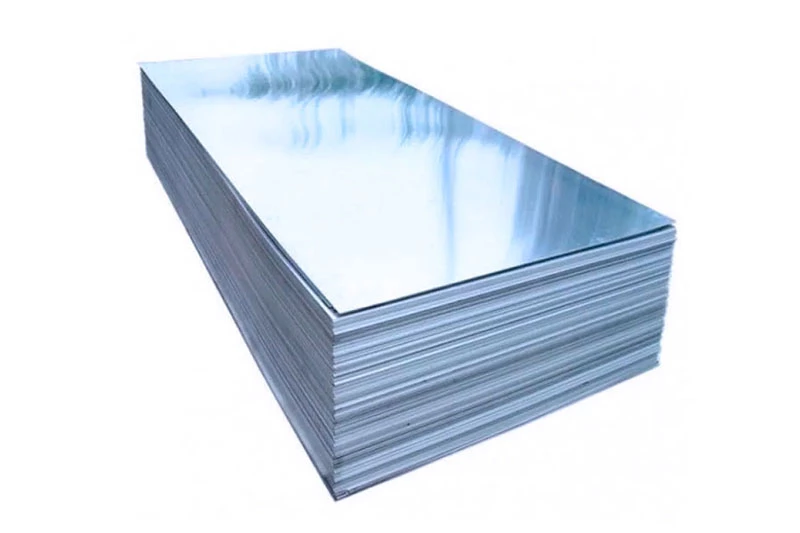DX54D+Z Galvanized Steel Sheet
Hot-dip galvanized steel sheet. The thin steel plate is immersed in the molten zinc tank, so that a thin steel plate with a layer of zinc is adhered to the surface. At present, it is mainly produced by continuous galvanizing process, that is, continuous immersion of rolled steel sheets in a galvanized bath with molten zinc to make galvanized steel sheets;
Alloyed galvanized steel sheet. This kind of steel plate is also manufactured by hot dipping method, but immediately after being discharged from the tank, it is heated to about 500°C to form an alloy film of zinc and iron. This kind of galvanized sheet has good coating adhesion and weldability;
Electro-galvanized steel sheet. The galvanized steel sheet produced by the electroplating method has good workability. However, the coating is thinner and the corrosion resistance is not as good as the hot-dip galvanized sheet;
Single-sided and double-sided poorly galvanized steel sheet. Single-sided galvanized steel sheet is a product that is galvanized on only one side. In welding, painting, anti-rust treatment, processing, etc., it has better adaptability than double-sided galvanized sheet. In order to overcome the shortcomings of uncoated zinc on one side, there is another galvanized sheet coated with a thin layer of zinc on the other side, that is, double-sided differential galvanized sheet;
Alloy, composite galvanized steel sheet. It is made of zinc and other metals such as aluminum, lead, zinc, etc. to make alloys and even composite plated steel plates. This kind of steel plate not only has excellent anti-rust performance, but also has good coating performance;
In addition to the above five types, there are color galvanized steel sheets, printed coated galvanized steel sheets, polyvinyl chloride laminated galvanized steel sheets, etc. But currently the most commonly used is still hot-dip galvanized sheet.
DX54D+Z Galvanized Steel Sheet Features
- Galvanized steel sheet is widely used in various environments and has a long anti-corrosion life. The anti-corrosion life is different in different environments.
- The processing cost is low, and the anti-corrosion cost of galvanized steel sheet is lower than other paint coatings.
- Durable, in the suburban environment, the standard galvanized anti-corrosion layer does not need to be repaired and can be maintained for more than 50 years. In cities or offshore areas, the standard galvanized anti-corrosion coating can be maintained for 20 years without repairs.
- Good reliability. The galvanized layer and the steel are metallurgically combined and become part of the rigid surface, so the durability of the coating is relatively reliable.
- The coating has strong toughness, and the zinc coating forms a special metallurgical structure, which can withstand mechanical damage during transportation and use.
- Integrity protection: All parts of the plated parts can be galvanized, even in recesses, sharp corners and hidden places can be fully protected.
- It saves time and effort. The galvanizing construction speed is faster than other coating construction methods, which can avoid the time required for on-site painting after installation.
DX54D+Z Galvanized Steel Sheet Equivalent Material
| Grade | Euronorm | China GB | Japanese JIS | US ASTM | ||
| EN 10346:2009 | GBT 2518-2008 | JIS:G3302-2005 | ASTM A653M | |||
| DX54D+Z | DX54D+Z | DX54D+Z | SGCD3 | DDS TypeC | ||
DX54D+Z Galvanized Steel Sheet Standard Specification
| Thickness | 0.12~2.5mm | ||||||
| Width | 1000mm, 1219mm, 1500mm, 1800mm, 2000mm, 2500mm, 3000mm, 3500mm, etc | ||||||
| Length | 1000-6000 or Since the custom | ||||||
| Surface | Normal (uneven) spangle/ Skinpassed spangle/ Regular spangle / Minimized spangles | ||||||
| Finish | |||||||
| Form | Coils, Foils, Rolls, Plain coil, Shim coil, Perforated coil, Chequered coil, Strip, Flats, Blank (Circle), Ring (Flange) etc. |
||||||
DX54D+Z Galvanized Steel Sheet Production process

DX54D+Z Galvanized Steel Sheet Metal Content
| Grade | Element | C | Si | Mn | P | S | Ti |
| DX54D+Z | Min. | – | – | – | – | – | – |
| Max. | 0.12 | 0.5 | 0.6 | 0.12 | 0.045 | 0.3 |
- Tensile strength :260~350 MPa
- Yield strength :120~220 MPa
- Elongation :≥36%
DX54D+Z Galvanized Steel Sheet Processing technology
1 Introduction
Hot-dip galvanizing, also known as hot-dip galvanizing, is a method in which steel components are immersed in molten zinc to obtain a metal coating. In recent years, with the rapid development of high-voltage power transmission, transportation, and communications, the protection requirements for steel parts have become higher and higher, and the demand for hot-dip galvanizing has also continued to increase.
2 Protection performance of hot-dip galvanized layer
The thickness of the electro-galvanized layer is usually 5-15μm, and the hot-dip galvanized layer is generally above 35μm, even as high as 200μm. Hot-dip galvanizing has good coverage, dense coating and no organic inclusions. As we all know, the anti-atmospheric corrosion mechanism of zinc includes mechanical protection and electrochemical protection. Under atmospheric corrosion conditions, there are protective films of ZnO, Zn(OH)2 and basic zinc carbonate on the surface of the zinc layer, which can slow down the corrosion of zinc to a certain extent. The protective film (also known as white rust) is damaged and a new film is formed. When the zinc layer is seriously damaged and the iron matrix is endangered, zinc will produce electrochemical protection to the matrix. The standard potential of zinc is -0.76V, and the standard potential of iron is -0.44V. When zinc and iron form a microbattery, zinc is dissolved as an anode. It is protected as a cathode. Obviously, the atmospheric corrosion resistance of hot-dip galvanizing to the base metal iron is better than that of electro-galvanizing.
3 Hot-dip galvanized layer formation process
The formation process of the hot-dip galvanizing layer is the process of forming an iron-zinc alloy between the iron matrix and the outermost pure zinc layer. The iron-zinc alloy layer is formed on the surface of the workpiece during hot-dip coating, which makes the iron and pure zinc layer very close. Good combination, the process can be simply described as: when the iron workpiece is immersed in molten zinc, a solid solution of zinc and α iron (body core) is first formed on the interface. This is a crystal formed by dissolving zinc atoms in the base metal iron in a solid state. The two metal atoms are fused, and the attraction between the atoms is relatively small. Therefore, when zinc reaches saturation in the solid solution, the two element atoms of zinc and iron diffuse each other, and the zinc atoms that have diffused (or infiltrated) into the iron matrix migrate in the matrix lattice, and gradually form an alloy with iron, and diffuse The iron and zinc in the molten zinc form an intermetallic compound FeZn13, which sinks into the bottom of the hot-dip galvanizing pot, which is called zinc dross. When the workpiece is removed from the zinc immersion solution, a pure zinc layer is formed on the surface, which is a hexagonal crystal. Its iron content is not more than 0.003%.
4 Hot-dip galvanizing process and related instructions
4.1 Process
Workpiece → Degreasing → Water Washing → Pickling → Water Washing → Dipping Helping Solvent → Drying and Preheating → Hot-dip Galvanizing → Finishing → Cooling → Passivation → Rinsing → Drying → Inspection
4.2 Description of the process
(1) Degreasing
Chemical degreasing or water-based metal degreasing cleaning agent can be used to degreasing until the workpiece is completely wetted by water.
(2) Pickling
It can be pickled with H2SO4 15%, thiourea 0.1%, 40~60℃ or HCl 20%, urotropine 3~5g/L, 20~40℃. The addition of corrosion inhibitor can prevent the matrix from over-corrosion and reduce the hydrogen absorption of the iron matrix. At the same time, the addition of fog inhibitor can inhibit the escape of acid mist. Poor degreasing and pickling treatments will cause poor adhesion of the coating, no zinc coating or peeling of the zinc layer.
(3) Immersion flux
Also known as solvent, it can keep the work piece active before immersion plating to avoid secondary oxidation, so as to enhance the bonding between the plating layer and the substrate. NH4Cl 100-150g/L, ZnCl2 150-180g/L, 70~80℃, 1~2min. And add a certain amount of anti-explosive agent.
(4) Drying and preheating
In order to prevent the workpiece from deforming due to the sharp rise in temperature during immersion plating, and to remove residual moisture, to prevent zinc explosion and cause zinc liquid explosion, the preheating is generally 80-140°C.
(5) Hot-dip galvanizing
It is necessary to control the temperature of the zinc liquid, the immersion time and the speed at which the workpiece is drawn from the zinc liquid. The extraction speed is generally 1.5 m/min. The temperature is too low, the fluidity of the zinc liquid is poor, the coating is thick and uneven, it is easy to produce sagging, and the appearance quality is poor; the temperature is high, the fluidity of the zinc liquid is good, the zinc liquid is easy to separate from the workpiece, and the phenomenon of sagging and wrinkles is reduced. Strong, thin coating, good appearance, high production efficiency; however, if the temperature is too high, the workpiece and the zinc pot will be severely damaged, and a large amount of zinc dross will be produced, which will affect the quality of the zinc dipping layer and easily cause chromatic aberration to make the surface color unsightly and high zinc consumption.
The thickness of the zinc layer depends on the temperature of the zinc bath, the immersion time, the material of the steel and the composition of the zinc bath.
In order to prevent the high temperature deformation of the workpiece and reduce the zinc dross caused by iron loss, the general manufacturer uses 450-470℃, 0.5-1.5min. Some factories use higher temperatures for large workpieces and iron castings, but avoid the temperature range of peak iron loss. However, we recommend adding an alloy with iron removal function and lowering the eutectic temperature to the zinc solution and reducing the galvanizing temperature to 435-445°C.
(6) finishing
The finishing of the workpiece after plating is mainly to remove the surface zinc and zinc nodules, which is completed with a special vibrator for hot-dip galvanizing.
(7) Passivation
The purpose is to improve the resistance to atmospheric corrosion on the surface of the workpiece, reduce or prolong the appearance of white rust, and maintain a good appearance of the coating. All use chromate passivation, such as Na2Cr2O7 80-100g/L, sulfuric acid 3-4ml/L, but this kind of passivation liquid seriously affects the environment, it is best to use chromium-free passivation.
(8) Cooling
Generally water cooling, but the temperature should not be too low or too high, generally not lower than 30℃ and not higher than 70℃
(9) Inspection
The appearance of the coating is bright, meticulous, without sagging or wrinkles. Thickness inspection can use coating thickness gauge, the method is relatively simple. The thickness of the coating can also be obtained by converting the amount of zinc adhesion. For the bonding strength, a bending press can be used to bend the sample at 90-180°, and there should be no cracks or peeling of the coating. A heavy hammer can also be used to test, and the salt spray test and copper sulfate corrosion test can be done in batches.
DX54D+Z Galvanized Steel Sheet Features
| Galvanized Steel Sheet Price List | Galvanized Steel Sheet FOB qingdao Per Ton (USD) | ||||||
| Galvanized steel sheet (Thickness 0.12~2.5mm) |
$680~890 | ||||||

